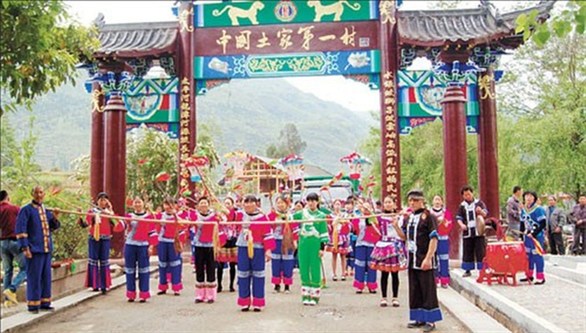Who needs beaches when mountains beckon?
 0 Comment(s)
0 Comment(s) Print
Print E-mail Shanghai Daily, May 12, 2015
E-mail Shanghai Daily, May 12, 2015
|
|
|
Local people from Tujia ethnic group offer a heart-warming welcome to visitors at the entrance to Yunshe village. |
Many people think a beach is the ideal holiday destination, but that notion short-changes the beauty, tranquility and sheer spectacle of inland mountain resorts.
So for a four-day holiday, I packed my bag and headed for Tongren in the east of Guizhou Province in southwestern China.
What a perfect area to visit, with its forested slopes, rushing streams, hot springs, clear air, caves and minority cultural sites. It is good value for money spent among some of the most hospitable people you will find anywhere.
The flight from Shanghai to Tongren Phoenix Airport takes only 2.5 hours. It’s a surprisingly busy airport, with direct flights from Beijing, Guangzhou, Hangzhou, Shenzhen, Kunming, Xiamen and Guiyang. Obviously, Tongren’s tourism delights are no longer such a well-kept secret.
Upon arrival in Tongren, the first thing I did was inhale the fresh mountain air. It had a scintillating quality that seemed to heighten enthusiasm for the days ahead.
Renting a car at the airport is an ideal mean of transport. It takes just two hours to drive to Fanjing Mountain, the most famous scenic spot in Tongren. For those who don’t want to drive, public buses to the mountain are available at the North Bus Station just opposite the main railway depot. First you have to take the airport bus into town. Traveling by bus is a longer trip and a certainly more cumbersome journey if you have a lot of bags to lug around.
The Fanjing Mountain Scenic Area is completely covered by natural forest. A shuttle bus takes visitors from the main gate to the cableway station at the foot of the mountain.
The cable car is a real treat. It travels up 1,200 meters in just 20 minutes, allowing a birds-eye view of picturesque valleys, tree tops and waterfalls, often ending in mountain fog. Bring a jacket. It can be cool at the top.
Fanjing Mountain is home to several rare plant and animal species, including Guizhou golden monkeys, giant salamanders and Chinese dove trees. It is part of the Wuling Mountain Range that stretches 420 kilometers through the provinces of Hunan, Hubei and Guizhou and the city of Chongqing.
Fanjing Mountain changes its face with the seasons. In spring, the azaleas are in full bloom. The landscape turns a rich green in summer, followed by the vivid palette of autumn leaves turning color. Winter brings a white blanket to the upper ridges.
During the Tang Dynasty (AD 618-907), the mountain was home to one of five Buddhist centers in China. As a base for the Maitreya beliefs, it came to symbolize the future according to Buddhism. Visitors can still see temples there.
The mountaintop also features the famous “mushroom stone.” For geology fans, hunting for conch fossils among rocks in an area that was actually under the sea 1.4 billion years ago is a popular pastime.
Minority villages offer a heartwarming welcome to ethnic culture and foods. Visit the Yunshe Tujia or Zhaisha Dong minority villages or the ethnic communities in Yamu Valley Scenic Area. You might even be asked to join in local singing and dancing!
From Jiangkou County where Fanjing Mountain is located, a convenient the next stop is Shiqian County, famous for its hot springs and ancient villages. The trip from Jiangkou to Shiqian takes about two hours.
Shiqian has a history dating back to the Qin Dynasty (221-206 BC). It was listed as an official historical and cultural site of Guizhou in 1992. Its history is marked by revolutionary bases established when the Red Army passed through Shiqian in 1934 and 1936, recruiting thousands of members.
Shiqian is rich in cultural heritage. Be sure to see the Shiqian Puppet Show, the Hairy Dragon Festival of the Gelao people and the Singing Spring and Tea Lantern. The Gelao people also host a Bird-Respecting Festival. The Chinese New Year is a perfect time to see the best ethnic performances.
Yaoshang and Loushang are two preserved ancient villages worth a visit. They are a favorite destination for backpackers.
Yaoshang Ancient Village is nestled deep in the mountains, about 38 kilometers from Shiqian County. It’s a typical old mountain village, with a rushing creek bisecting the town.
The top edges of its yellow-timbered houses are shaped like bird tails, and the totem of the village is a giant eagle statue on a calabash right beside the main square. There’s a delightful home-stay beside the pavilion bridge over creek where you can sit and marvel at the brightly colored birds flying about the pavilion.
Either on foot or by horse carriage, you can travel to the foot of Foding Mountain, where snack stalls are clustered beside the wooden shelter bridge. Don’t miss the green tofu, the fish-shaped rice noodles and the yellow rice zongzi. Some of snacks can be quite spicy, so you may have to ask the vendors to hold the red chili powder.
From the bridge, you can hike to a waterfall about half-an-hour away. The trail runs along a running creek, providing the soothing sound of rushing water. Pavilions along the way offer brief respites for the foot-weary.
The waterfall is the highlight of hiking. It is actually two waterfalls, one is about 10 meters wide, and the other is narrower but 20 meters high. How refreshing it was to splash the cool waters on a sweaty face and hands!
The layout of Loushang Ancient Village, about 18 kilometers northwest of Shiqian County, is unique. About 2,000 meters of paved roads in the village interlace like the Chinese character shou, which means “longevity.” Old wooden houses are clustered near Tianfu Well, the water supply for the village, which has had heritage protection as a national cultural relic site since 2013.
Shiqian is also famous for its hot springs. There are 36 hot spring sites, with Chengnan Hot Spring the most famous. Its water temperature is a constant 45 degrees Centigrade. It springs from stone gaps at the foot of Songming Mountain. Visitors have a choice of enclosed or outdoor springs. The spas were first developed as far back as 1606 during the Ming Dynasty (1368-1644).
Just north of downtown Shiqian is Longevity Palace, or Wanshougong. It is well worth a visit. The palace was listed as a national cultural relics site in 2001. On its stage, puppet shows are performed, and in the main hall, local residents come to worship their ancestors. On the stone square of the site, there is regional folk dancing. In videos, performers dressed in traditional costumes enact roles such as the Land God or tea-pickers.
Fuwen Temple, also known as the Learning Temple, is located in eastern Shiqian. It was built in 1413, the 11th year of the reign of Emperor Yongle in the Ming Dynasty. It was listed as national cultural relics site in 2013.
Yuanyang Lake, or Mandarin Duck Lake, is home to thousands of the namesake fowl. The ducks were originally migratory, but they apparently liked the serenity of the site so much that they became permanent residents. In 2011, the State Forestry Bureau designated the lake as a state wetland park.
So much for terrestrial wonders; it’s time to explore underground. Jiulong Cave is a karst feature about 17 kilometers southeast of Tongren, alongside the crystal green Jinjiang River.
The cave features 18 stalactites more than 10 meters high, with the biggest 45 meters high and 16 meters in diameter. It’s really spectacular to see all the geologic formations in the cave, including “stone flowers,” “stone curtains” and “stone animals.” It’s a living site, as dripping water continuously adds to shapes and sizes.
Last but not the least on a trip to Tongren, visitors should take the time to enjoy local organic cuisine, rice wines and regional green teas.







